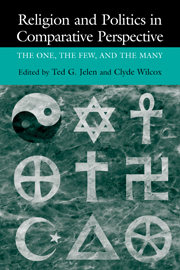Book contents
- Frontmatter
- Contents
- List of Contributors
- Preface
- 1 Religion: The One, the Few, and the Many
- 2 The Challenge of Pluralism
- 3 Catholicism, Politics, and Culture in the Republic of Ireland
- 4 Religion and Politics in Iberia
- 5 The Religious Dimension of Israeli Political Life
- 6 Between Heaven and Earth
- 7 Islamism in Contemporary Arab Politics
- 8 Religion and Politics in a Secular Europe
- 9 Religion and Democracy in South America
- 10 Looking for Hope in Central America
- 11 Religion and Politics in India
- 12 Religion and Politics in Japan
- 13 Religion and Politics in an Open Market
- 14 The Political Roles of Religion
- Index
1 - Religion: The One, the Few, and the Many
Published online by Cambridge University Press: 05 June 2012
- Frontmatter
- Contents
- List of Contributors
- Preface
- 1 Religion: The One, the Few, and the Many
- 2 The Challenge of Pluralism
- 3 Catholicism, Politics, and Culture in the Republic of Ireland
- 4 Religion and Politics in Iberia
- 5 The Religious Dimension of Israeli Political Life
- 6 Between Heaven and Earth
- 7 Islamism in Contemporary Arab Politics
- 8 Religion and Politics in a Secular Europe
- 9 Religion and Democracy in South America
- 10 Looking for Hope in Central America
- 11 Religion and Politics in India
- 12 Religion and Politics in Japan
- 13 Religion and Politics in an Open Market
- 14 The Political Roles of Religion
- Index
Summary
Fifty years ago, many social scientists assumed that “religion in the modern world was declining and would likely to continue to decline until its eventual disappearance” (Casanova 1994, p. 25). In Western Europe levels of public religiosity had declined to low levels, and many assumed this to be the likely path of most societies. Predictions that secularism would soon sweep the United States and the rest of the world were commonplace; by the end of the millennium religion was expected to be confined primarily to less developed societies. At the very least, governments and politics were expected to be freed of the influence of religious elites and citizens.
In 2000, religion is resurgent. George Weigel (1991) argues “the unsecularization of the world is one of the dominant social facts in the late twentieth century.” Samuel Huntington (1996) argues “In the modern world, religion is a central, perhaps the central, force that motivates and mobilizes people” (p. 66). Huntington sees a religious revival underway at the end of the twentieth century based partially on recruitment but even more on the reinvigoration of religious traditions. This reinvigoration means that religion is today a source of political mobilization in many nations, and also the source of policy disputes over the relationship between church and state.
Religion is the source of some of the most remarkable political mobilizations of our times. In Iran, Islamic activists led a powerful popular revolution that brought millions of Iranians into the street in a successful effort to overthrow the Shah.
- Type
- Chapter
- Information
- Religion and Politics in Comparative PerspectiveThe One, The Few, and The Many, pp. 1 - 24Publisher: Cambridge University PressPrint publication year: 2002
- 4
- Cited by



